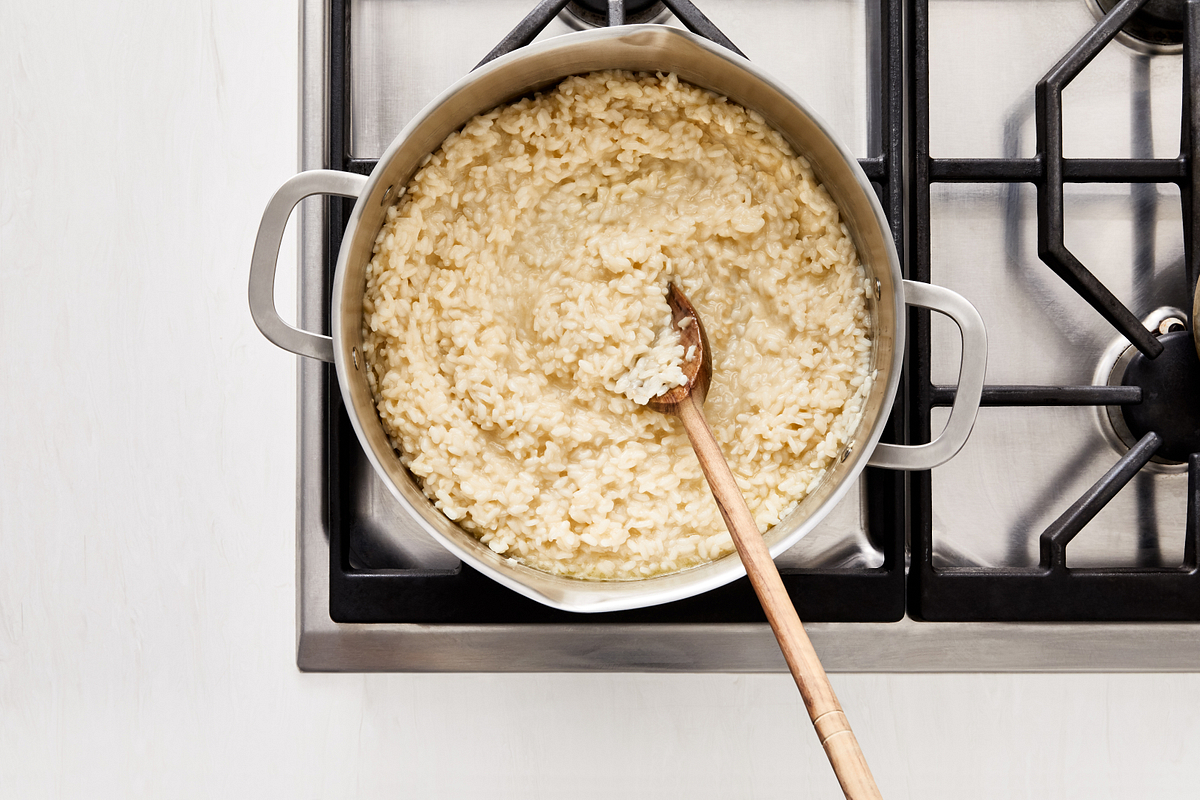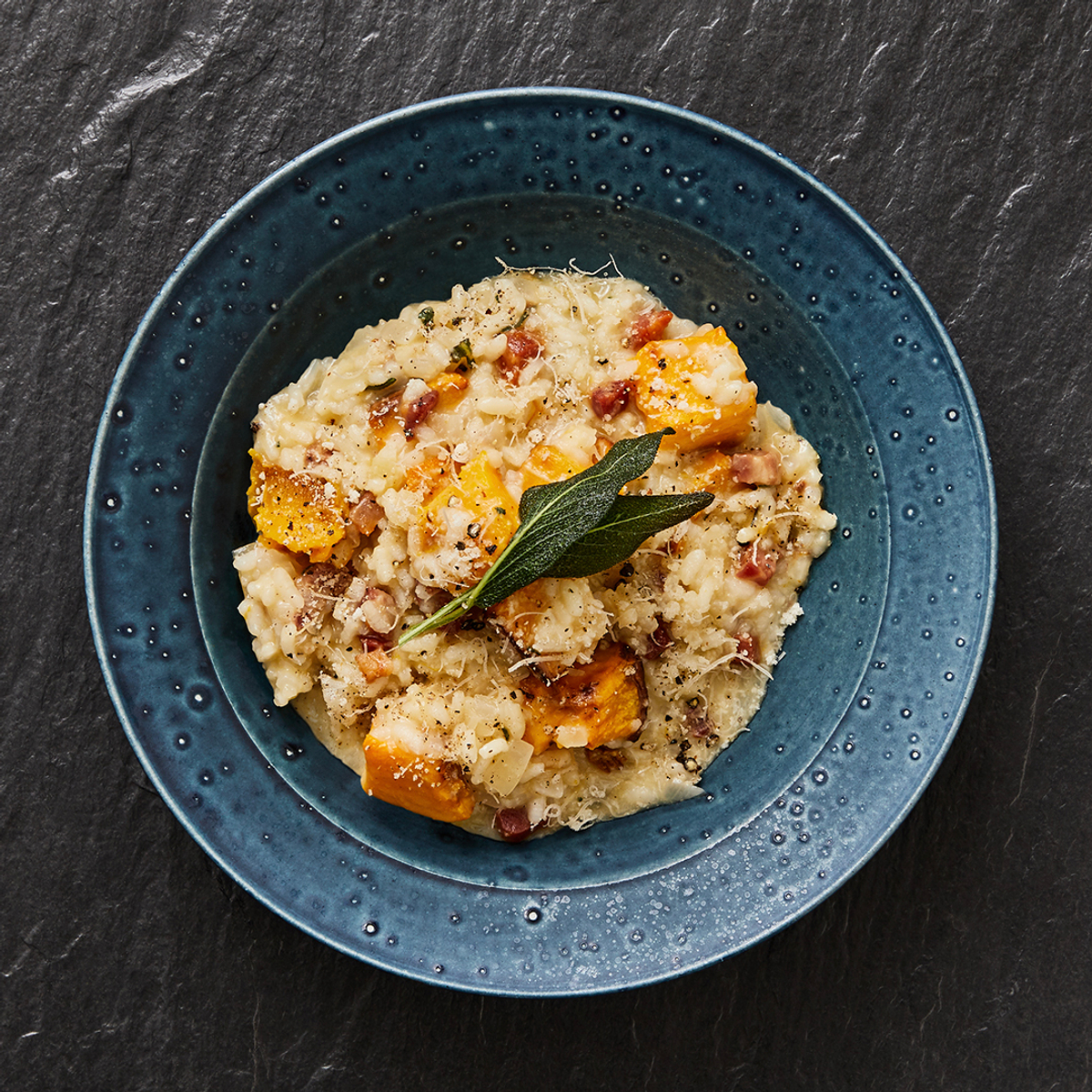When it comes to recipes that set great home chefs apart from the rest, a rich and luxurious risotto is at the very top of the list. In my experience, I’ve found that for this particular dish, it’s more of a technique rather than a recipe. And, once you master the basics you can wield this dish to any flavor profile and intriguing ingredient of your choice.
If you’re looking to make the perfect creamy risotto but haven’t quite reached the level of expert home chef, or you’re just looking for more inspiration to have in your backpocket, I’ve got what you need. I’ll use a classic recipe from my absolute favorite rice brand RiceSelect® to guide you through each step of the process and give you plenty of recipe inspiration along the way.
For the Love of Risotto
To perfect a dish, it’s important to understand its origins and the surrounding culture as well. Risotto originated in Northern Italy, in fact, the name for this dish is taken from the Italian word riso, meaning rice.
So, what is risotto exactly? At its simplest, risotto is rice cooked in broth that is added in slowly until it reaches a creamy texture. The culture of this rice dish is deep-rooted in the history of Italy and at times was considered to be the country's national dish. Nowadays, there is a warmth and versatility to risotto that can’t be matched. True of many Mediterranean cuisines, this dish can’t be rushed, much like the culture and lifestyle in many areas of Italy is not rushed.
I believe the love and patience that goes into making this indulgent dish is worth it. If you’re looking to make your own at home, the first step is to start with quality ingredients beginning with the rice.
Essential Risotto Rice
For me, there is no other rice than RiceSelect® Arborio Rice when I make risotto. The reason I prefer this medium grain variety is because it contains the perfect amount of the starch amylopectin in contrast to others with low or high starch that prove too sticky or loose to merit the ideal texture.
The higher quality of the rice grains have a direct impact on the starch content, which in turn affects the ability to achieve that signature silky texture and al dente core. This is an integral factor for preparing an unforgettable risotto. It’s such a common variety that many refer to Arborio Rice as Risotto Rice.
Risotto Steps
The creaminess of risotto is determined by a combination of factors: the rice type (Arborio), temperature, tools and (perhaps the most difficult to master) patience. Using a Classic Italian Risotto Recipe as a guide, I’m going to walk you through each step and show you why it’s important and a few tips along the way.
Step 1. Heat oil and butter in a large heavy saucepan.
Many chefs use a combination of butter and oil to get the benefit of the buttery flavor, but the added oil helps to keep the butter from burning. This is due to the differing smoke points of each cooking fat. Butter adds a rich flavor but its smoking point is 350°F, whereas extra virgin olive oil has a smoke point of around 374–405°F.
Step 2. Add shallots and garlic and sauté over medium heat until shallots are tender.
This step is all about adding flavor into your rice dish. Start with an aromatic base by infusing the oil and butter mixture together for your rice to simmer in later on.
This basic recipe uses shallots and garlic, but however other recipes might use a combination such as shallots, celery, garlic, thyme, rosemary and more like in this Mushroom Risotto Recipe.
Or, you may choose to not start with an aromatic base if you will be adding in herbs or sauces later on like in this homemade Pesto Chicken Risotto Recipe.
Step 3. Add rice and stir until all grains are coated and slightly translucent.
While it might seem unnecessary, that couldn’t be farther from the truth. Toasting the uncooked rice is essential as it works to create a shell around each grain, which will later allow them to slowly absorb the moisture without getting too soggy and mushy or bursting open like popcorn.
Tip: To toast your rice perfectly, once the butter is melted or the aromatic vegetables are sautéed, turn the heat to high, stirring constantly until the rice just begins to pop, about 1 minute. It should not color.
Step 4. Add wine and stir over medium-high heat until all wine is absorbed.
Many might wonder if adding the wine is essential for making risotto? And the answer is no. You can make a risotto without the wine, but it lends flavor and a touch of acidity to the dish that balances out the richness. If you are adding it, it needs to be added before the broth in order to release any flavor from the bottom of the cooking pan as well as allow time for the alcohol to cook off.
If you’d prefer to skip it, simply omit it or add a touch of lemon juice, white or red wine vinegar in with the broth.
Step 5. Add about 1 cup of hot broth to rice and stir constantly until almost all the broth is absorbed. Continue to add hot broth, one cup at a time, stirring until liquid is absorbed, before adding more broth. Use enough broth to cook the rice until it is just al dente.
Unique to risotto, the broth is added in slowly and not all at once. The broth used can be either stock or broth derived from meat, fish or vegetables if desired. It can also be infused with seasonings such as sage and bay leaf like in this Pumpkin and Sage Risotto Recipe. You may also choose to add in saffron for an orange-red hue, or mashed pumpkin for a thicker texture and punch of subtle sweet taste after it has roasted.
This is an area where you can really let your creativity shine when making risotto as it will be the flavor infused into the arborio rice.
A few tips for this step include:
The broth added in should always be warm or hot. Why? Cool broth takes longer to warm up in the pan and may even shock your grains into holding onto the starch instead of releasing it while it continues to cook.
The amount of liquid used is important. You don’t want to drown the rice, so be patient and slowly add in ½ cup of hot broth. The broth should be fully absorbed before adding in the next ½ cup.
The creamy texture comes in part from the starch content in the rice. And, the starch is released through continual stirring when the broth is added. This helps them to flow and integrate throughout the dish.
Lastly, keep an eye on the temperature of your rice. I suggest maintaining a consistent medium heat for proper release of the starches and will prevent scorching.
Step 6. Remove from heat and stir in Parmigiano-Reggiano.
Lastly, while I’ve already established that the creamy texture comes from the rice, temperature, etc., one important factor to keep in mind is that the texture does not come from added cream or cheese. Those are simply added to enhance the flavor even more.
If desired, add in an extra pat of butter, Parmigiano-Reggiano or Mascarpone cheese. Try it out in this incredible recipe by my blogger friend Lindsey Baruch (Lindsey Eats) with a Sweet Corn Parmesan and Mascarpone Risotto Recipe.
Finally, if you’re wondering how long risotto takes to cook, it all depends on the amount of liquid you use at a time and your desired texture, but experts say it should take about 18-30 minutes.
Troubleshooting Your Risotto
If you’re tried the above method but still not reaching the ideal results of your dream risotto, I’ll take you through some of my tips and answer a few common questions.
What are common risotto mistakes, and how do I fix them?
Risotto not creamy enough? In this case, avoid adding any extra butter or cream as these are solely for flavor and not texture. This is where patience comes into play. Continue to stir your risotto constantly in order for the rice to release the starch continually. Also ensure you are adding hot broth and that the temperature of your pan is at a constant simmer.
Risotto is too mushy? See the tip above for toasting the rice to help create that outer shell. Also, ensure you are not adding in too much liquid. I always taste my risotto frequently in order to gauge the flavor, texture and salt level.
Risotto is too salty? Some may oversalt their risotto, and so to reduce that, begin with a low-sodium broth option or use your own homemade cooking liquid for incredible results. Also, keep in mind that any added ingredients such as cheese or roasted vegetables may also include a touch of added salt of their own.
TIP: If your risotto ends up overly salty, cook 1 cup of arborio rice separately using a 2:1 water to rice ratio and boil for 20 minutes (or until the liquid is absorbed). Fluff it with a form and stir that into your finished risotto to even out the flavor.
What are the preferred tools or utensils for cooking risotto?
First, I would use a wide, 3-4 quart, heavy bottom pan for heat conductivity and steady liquid absorption while cooking. Use a large enough pan that the grains are not compact and overflowing. They need to have space but not too much space that they won’t bump into each other when stirring and therefore not release their starch.
Secondly, a wooden risotto spoon is preferred since it protects your pan from scratches while stirring. Also, the hole in the center allows for a constant flow and minimal grain breakage for optimal results.
Can I use an Instant Pot to make risotto?
Yes, you can use an Instant Pot to make risotto at home! Although the process is quite different from what I’ve stated above. This recipe for an Instant Pot Bacon and Egg Risotto will offer you the information you need to get started.
How do I reheat risotto?
Contrary to common belief, you can reheat risotto leftovers. Start by ensuring that your risotto is properly stored in an air-tight container in the fridge after preparation. I suggest eating the leftovers within 2-3 days of cooking. To do that, I prepare hot broth and add it slowly to my risotto leftovers in a pan which will help the grains to reach a temperature gradually, relaxing the starches and restoring the creamy consistency.
Alternatively, one of my favorite ways to use leftovers is to make Italian Arancini rice balls.
More Risotto Recipes
Using Arborio Rice, your risotto is an incredible base for self-expression. Get creative with fresh and seasonal ingredients or add other comforting flavors. If you’re in need of a bit more inspiration, I’ve compiled some of my favorite satisfying and elegant meal options below to really impress your dinner guests!
Seafood
Create something unforgettable by elevating your meal with seafood. Make your guests or family feel like it is a special occasion by using any one of the following:
Vegetables
Add a vibrant dash or green to your risotto with asparagus and other greens in this Spring Green Risotto Recipe. To finish this elegant dish off, drizzle with a homemade dandelion pesto.
For a rich red color, this Beef and Goat Cheese Risotto is a wonderful addition to your meal spread. Hearty enough to be a vegetarian main dish, it can also double as a side dish for any occasion.
Bonus: Arancini Recipes
These golden brown rice balls are a savory mouthful of flavor with a subtle crunchy texture. Arancini rice balls are stuffed with a sweet or savory filling and deep-fried to perfection. Form them into a ball or volcano shape before placing in oil or an Air Fryer.
Other Meal Inspiration
For something else with that Mediterranean flavor why not take a look at an Orzo recipe. Or alternatively for something a bit more exotic why not try an Israeli Pearl Couscous recipe?
No matter which of these recipes you choose to make, RiceSelect® is at the center of all of it. Create unforgettable meals like this shrimp salad recipe and unforgettable moments with the people that matter the most in the kitchen and at the table!






